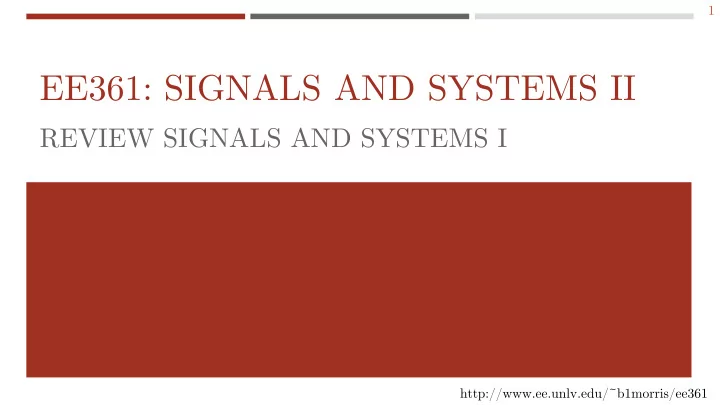

1 EE361: SIGNALS AND SYSTEMS II REVIEW SIGNALS AND SYSTEMS I http://www.ee.unlv.edu/~b1morris/ee361
2 SIGNALS AND SYSTEMS I RECAP Signals – quantitative descriptions of physical phenomena Represent a pattern of variation System – quantitative description of a physical process to transform an input signal to an output signal The system is a “black box” E.g. Physical system Abstract system 𝑤 𝑑 𝑢 T 𝑤 𝑡 (𝑢) 𝑗(𝑢)
3 SIGNALS This course deals with signals that are a function of one variable Most often called “time” Continuous time (CT) signal 𝑦 𝑢 , 𝑢 ∈ ℝ Time is a real valued (e.g. 1.23 seconds) Discrete time (DT) signal 𝑦 𝑜 , 𝑜 ∈ ℤ Time is discrete (e.g. 1 or 5) Signal is a sequence and 𝑜 is the location within the sequence
4 BASIC SYSTEM PROPERTIES Memoryless Stable Output does not depend on BIBO criterion: bounded input past/future values results in bounded output Invertible Linear Another system exists that accepts 𝑧(𝑢) as input and returns 𝑦(𝑢) Given 𝑈 𝑦 𝑢 → 𝑧(𝑢) Causal 𝑏𝑦 1 𝑢 + 𝑐𝑦 2 𝑢 → 𝑏𝑧 1 𝑢 + 𝑐𝑧 2 (𝑢) Output only depends on past or present values Time Invariant Realizable system since it does not need future values Time shift on input results in same time shift on output Implement non-causal systems with delays 𝑈 𝑦 𝑢 − 𝑢 0 → 𝑧 𝑢 − 𝑢 0
5 LTI SYSTEM Linear and time-invariant systems LTI 𝑦[𝑜] 𝑧[𝑜] 𝜀[𝑜] ℎ[𝑜] Impulse response ℎ 𝑜 completely specifies input/output relationship 𝑧 𝑜 = 𝑦 𝑜 ∗ ℎ 𝑜 𝑦[𝑜] ℎ[𝑜] ∞ 𝑦 𝑙 ℎ[𝑜 − 𝑙 = 𝑙=−∞ ∞ = ℎ 𝑙 𝑦[𝑜 − 𝑙] 𝑙=−∞
6 LTI PROPERTIES Memoryless ℎ 𝑢 = 𝑏𝜀(𝑢) , where 𝑏 is a constant Invertible 𝑦[𝑜] ℎ[𝑜] 𝑧[𝑜] [𝑜] 𝑥 𝑜 = 𝑦[𝑜] ℎ 𝑜 ∗ 𝑜 = 𝜀 𝑜 Causal ℎ 𝑢 = 0, 𝑢 < 0 Does not depend on future input – see convolution integral Stable Absolutely integrable/summable ∞ ℎ 𝜐 𝑒𝜐 < ∞ −∞
7 EIGEN PROPERTY Eigen function (signal) for an LTI system is a signal for which the output is the input times a (complex) constant 𝑦 𝜇 (𝑢) ℎ(𝑢) 𝑧 𝑢 = 𝜇𝑦 𝜇 (𝑢) eigenvalue CT: 𝑓 𝑡𝑢 → 𝐼 𝑡 𝑓 𝑡𝑢 𝐼(𝑡) – eigenvalue from Laplace Transform (system/transfer function) DT: 𝑨 𝑜 → 𝐼 𝑨 𝑨 𝑜 𝐼 𝑨 - eigenvalue from Z-transform (system/transfer function)
Recommend
More recommend